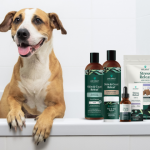This is a sponsored guest post.
As a dog owner, it’s important to look out for any skin issues and skin conditions that might be affecting your dog. Skin issues tend to be more common in dogs during the summer, where allergies tend to be more likely. Skin problems can be very uncomfortable and even painful for a dog. In some cases, skin conditions in dogs might be due to another health condition, which is why a vet visit to rule this out is important. Dogs can suffer from mild to more severe skin conditions, and skin conditions and issues in dogs should be treated as soon as possible to prevent them getting worse. Parasite allergies, environmental allergies, food allergies and bacterial infections are some of the most common causes of skin conditions in dogs. Keep reading to find out more.
Symptoms of Skin Conditions in Dogs
If your dog has a skin condition, then you will usually notice that they are itching a lot more than usual. However, it can be difficult to figure out exactly what is leading to this itching and irritation without the help of a vet. It’s normal for all dogs, like humans, to scratch themselves occasionally if they have an itch. However, if your dog has a skin condition, you may notice frequent or prolonged periods of scratching. Along with this, other common signs and symptoms include hair loss, skin sores, rashes, dry skin, redness, dandruff and lumps.
Environmental Allergies
Itching that starts suddenly on areas like the stomach, chest, face and feet can be a sign that your dog is allergic to something in the environment. This type of allergy is known as Atopy, and is quite similar to hay fever in people, in that it’s one of the most common dog seasonal allergies. Your dog’s allergies might be in response to the heat or increased pollen in the air. However, unlike humans who often have symptoms like sneezing or itchy eyes, the allergy symptoms are more likely to be characterized by itchy skin in your dog.
Food Allergies
An allergic reaction to their food is another common cause of allergy symptoms in dogs. If your dog is allergic to something in their diet, this can cause a lot of itching and other symptoms. Itching in areas such as the face, feet, and anus is often more common with food allergies. Food allergies might be to anything in the dog’s diet including grains, vegetables, and even some meat products. Putting your dog on an elimination diet that rules out potential allergens is the best way to get to the bottom of what is causing these symptoms to appear in your dog.
Fleas and Ticks
If your dog is scratching a lot more than usual, then fleas and ticks rather than a skin condition might be the problem. With most dogs, it’s easy to keep fleas and ticks at bay by using a spot-on flea treatment regularly. However, your dog might be more susceptible to getting fleas and ticks at certain times of the year, often in the spring or fall. Both fleas and ticks bite dogs and feed on their blood. This causes the insect’s saliva to enter the body, which can lead to an allergic reaction with itching and irritation.
Yeast Infection
A yeast infection can occur anywhere on the warmer parts of your dog’s body. These infections tend to be more common in hard-to-reach areas like in between toes, the groin or perineum, and the ear canal. It can lead to thickening of the skin, which can be itchy and uncomfortable for your dog. You might notice that your dog is frequently itching or biting the affected area. The area may become discolored and emit an unpleasant smell. Topical creams, washes, and oral tablets can be prescribed by your vet for this problem.
Ringworm
Despite the name, ringworm is actually a fungus, rather than a worm. It is very contagious to both dogs and humans. Ringworm in dogs tends to look like circular, crusty bald patches on the skin. There is usually some obvious hair loss around the affected area. Patches are often found on the dog’s paws, head, front legs and ears. The skin around the infected area may be red and inflamed, especially if they have scratched and irritated the area. Contact your vet immediately if you think that your dog has ringworm. You will also need to wash all their bedding and any other fabrics that they have come into contact with on a high temperature. Wash your own hands regularly to prevent spreading the infection to yourself.
Skin conditions and other skin problems in dogs can have a number of potential causes. As a dog owner, it’s important to be aware of what might lead to these symptoms in your dog and the best way to treat them.

Hi there! I am Emily Evert, the owner of Emily Reviews. I am 28 and live in a small town in Michigan with my boyfriend Ryan and our two pugs. I have a large family and I adore my nieces and nephews. I love reading memoirs, and learning about child development and psychology. I love watching The Game of Thrones, Teen Mom, Sister Wives and Veep. I like listening to Jason Isbell, John Prine, and other alt-country or Americana music. I created Emily Reviews as a creative outlet to share my life and the products that I love with others.
This post currently has no responses.






Leave a Reply